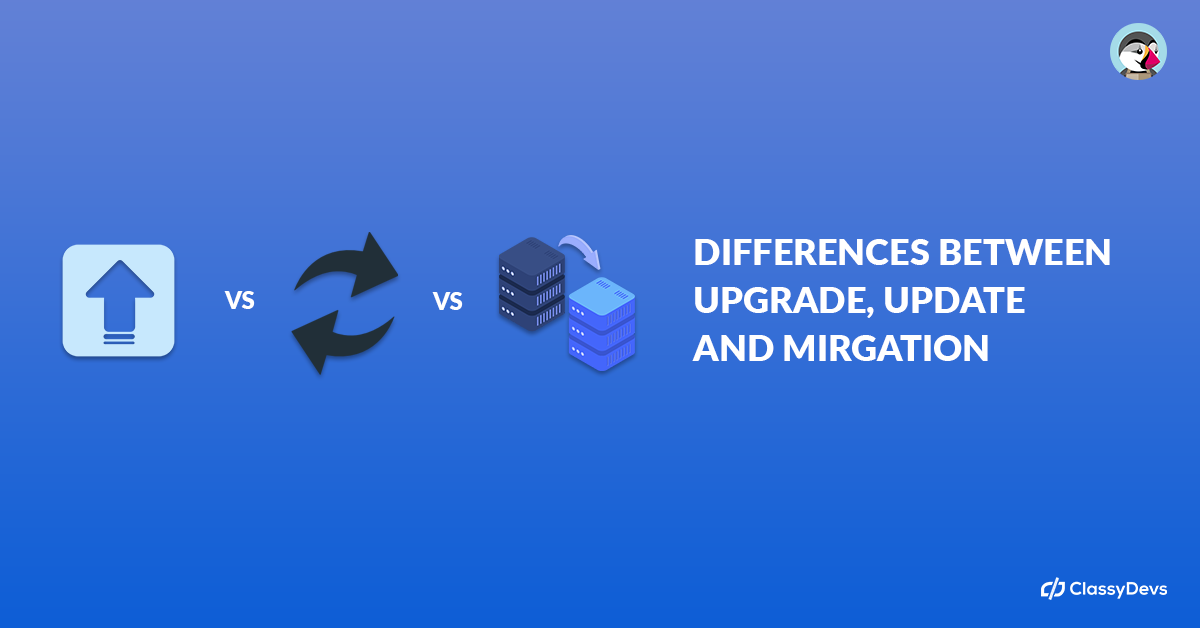Differences between upgrade, update and migration in Prestashop: If your online store is Prestashop, surely at some point you will have heard the words Prestashop upgrade, update, migration and you will have wondered. Okay, but aren’t they the same? What is the difference between upgrade, update, and migration in Prestashop? Do I have to do them? Can I make them myself? What benefits do they bring? In this article, I will discuss the Differences between upgrade, update, and migration in Prestashop.
Differences between Upgrade, Update, and Migration in Prestashop
What is an update and what are its types?
An update is nothing more than the modification of files, that is, when you update your online store you authorize the software to execute certain processes that change the old files or the previous version for new ones. This action will modify the entire codebase of your CMS or platform.
And not only the files are replaced, but the database also changes, the most common is that new tables are added or some of the existing ones are modified by adding more columns, or the tables that should not be used are simply eliminated.
It is important to clarify that all these changes are made on the files and tables of the core database of the software operation. With the update, modules or templates are not modified other than those that the software had by default when it was installed.
Now, there are several types of updates, among which are:
Update by patch
In simple terms, an update is usually a patch that is rolled out over a previous version of the software, which generally fixes the bugs, regressions, or translation errors of that previous version.
Update update
When you talk about Updates or updates, you are referring to a minor revision of the software. This review is done to optimize all the software together. All in order to solve the problems of interruption of its operation, or any other error that may arise, as well as to add new functions. These types of updates do not allow you to change versions, that is, to go from the current version to a lower or higher version.
Upgrade update
The upgrade update consists of an important revision of the software, in other words, it is when the software changes its version completely and goes, for example, from version 1.6 to 1.7.
This type of update allows you to go from the primary or base version that is obtained when the software is downloaded to the current version, which of course must be superior in terms of innovation and performance.
Making an update is not a minor task and it should be done by a specialized company with experience in Prestashop updates or you run the risk that your online store stops working and all your visits see from now on is a screen in white.
Even when they are minor updates that apparently you can do with a module and instantly, trust me. In most cases, these updates end in disaster, so do not risk and seek professional help.
What is Migration?
Although there are certainly cases in which you have no choice but to update the software, it is not always necessary to get there, you also have the option of moving the content between two versions of the same software. This is called migration.
Migration can be done from one platform to another, such as migrating from Magento to Prestashop or within the same platform, such as migrating all data from a Prestashop 1.6 to a clean installation Prestashop 1.7
So, migration is nothing more than moving all the data of the online store from the version of the software that was used to store the content initially to a higher version or simply more appropriate, whether it is a new environment such as of the same system. This process does not imply the modification of the database or the files, only the program extracts all the information about products, images, categories, orders, invoices, customers, etc., from their environment of origin, and they are entered in the landing page.
This process does not affect the functionality of the store itself, because it does not touch its configuration, that is what makes this process almost 100% functional, the failure would occur if the data is not imported correctly, if this happens, it may be that certain problems arise in your online store, it could be that the client cannot log in or that the products are not seen, but the software as such and its operation would not be affected.
Something that you should bear in mind is that migration implies a certain notion of irreversibility since the data is separated from the technical context in which it was created, as is the case with the redesign of the store, or the need to adapt the code source or specific developments, the latter implies the change of certain modules and themes, adjustments, patches, etc.
Advantages and disadvantages of migration
The most notable advantage of this process is that the data import will not affect the core or the functioning of the page, as already mentioned. And, if it happens to you that the import was not carried out correctly, you will only have to delete the data that you already imported and import again. Don’t worry, I reiterate that your software will not be affected.
Another advantage that migrations offer is that when they are carried out, everything that is old is cleaned up and there are no residues of information in the database or in the files, which does happen when we have already updated the program many times or have installed many modules.
On the other hand, the most obvious disadvantage of migration is that you will need to configure all the software from the beginning, not just the catalog, the orders, or your client portfolio. For this, you will need to install and configure modules, templates, payment methods, taxes, translations, carriers, etc.
Good reasons to update or migrate your online store
From the Differences between upgrade, update and migration in Prestashop, Among the reasons why it becomes necessary to update or migrate your online store, the most relevant are the following:
- The version of the software you use is no longer secure or offers no maintenance.
- The version you have no longer meets expectations and does not provide the technological performance, ergonomics, or positioning (SEO) that your page requires. If so, you need to benefit from more optimized features.
- When the software version no longer complies with the legal provision
- The version you are using is already outdated or unusable
- When it does not guarantee the sustainability and efficient progress and growth of your online store.
Read More:




















